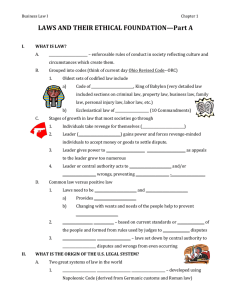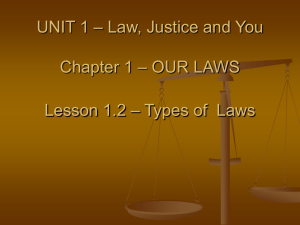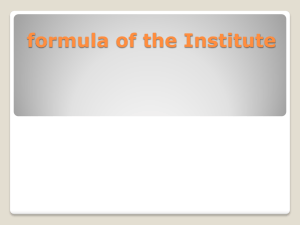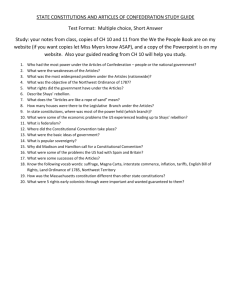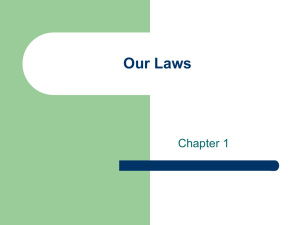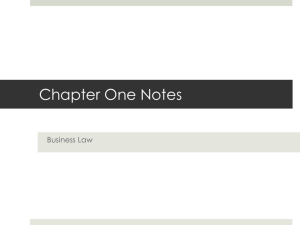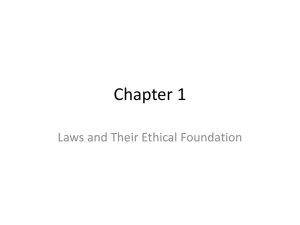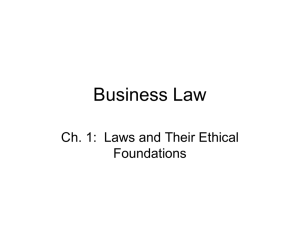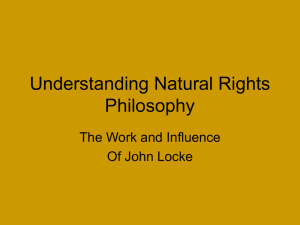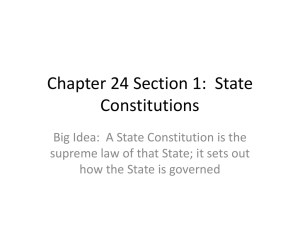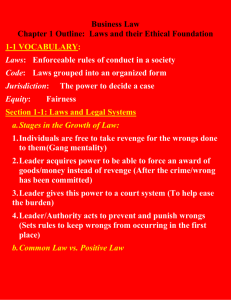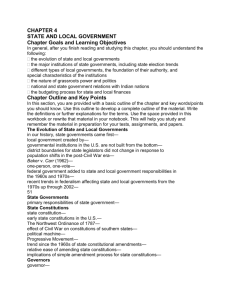Law for Business and Personal Use
advertisement
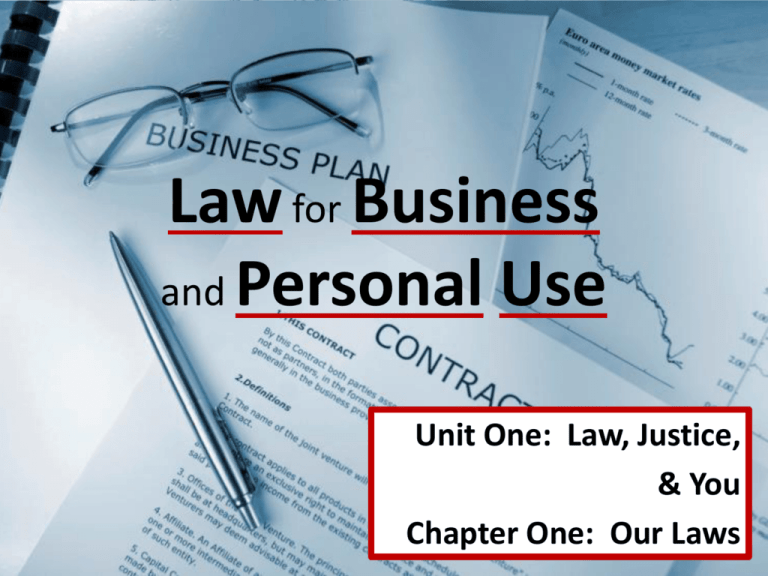
Law for Business and Personal Use Unit One: Law, Justice, & You Chapter One: Our Laws Electronic Issues in Business Law Starts Page XV in Textbook – Before Chapter One Read – Foundations of Cyber Law The Birth of the Internet - Discussion The World Wide Web - Discussion Evolving Legal Issues in Cyberspace The Ongoing Issue of Jurisdiction Internet Issues Involving Trademarks Internet Issues Involving Copyrights DVD Current Internet Issues Involving Contracts Internet Issues Involving the Right of Privacy Internet Issues Involving Freedom of Speech Additions – Article on SOPA Cyber Law Discussion more in-depth Chapter One: Our Laws Objectives • Explain the stages in the evolution of law. • Describe the differences between common law and positive law. • Describe the difference between law courts and equity courts. 1-1 Chapter One: Page 4 – HOT Our Laws DEBATE. Read the Hot Debate Topic. Look at ???’s. Get ready for discussion… The laws, or enforceable rules of conduct in society, reflect the culture and circumstances that create them. Laws may be grouped into an organized form called a code. 1-1 Chapter One: Our Laws Stages in the Growth of Law… Most societies go through four distinct stages in forming their legal systems… • Individuals take revenge for wrongs done to them. • Awards of money or goods are substituted for revenge. • Court systems are formed. • A central authority figure intervenes to prevent and punish wrongs. 1-1 Chapter One: Our Laws Common Law vs. Positive Law… • Laws based on the current standards or customs of the people is called common law. Common law usually is pronounced by judges who settle peoples disputes. • Positive law is dictated from central authorites. English Common Law… • The King’s Courts • Jury • English common law adapts to changes in society, the English common law system has been a model for legal systems worldwide. The system of law in the United States is based on the English common law. 1-1 Chapter One: Our Laws Equity: An Alternative to Common Law… • The English common law courts carefully followed precedent. This means the courts used prior cases as a guide for deciding similar new cases. • Equity refers to fairness. 1-1 Chapter One: Our Laws Objectives • Explain how constitutional, statutory, case, and administrative laws are created. • Explain how to resolve conflicts between constitutional, statutory, case, and administrative laws. • Describe the differences between criminal and civil, substantive and procedural, and business and other forms of law. 1-2 Chapter One: Our Laws Laws in this country are created at all three levels of government – federal, state, and local. The laws at each level consist mainly of constitutions, statutes, administrative regulations, and case law…. Constitutions… A constitution is a document that sets forth the framework of a government and its relationship to the people it governs. When constitutions are adopted or amended, or when courts interpret constitutions, constitutional law is made. Constitutions allocate powers (1) between the people and their governments, (2) between state governments and the federal governments, and (3) among the branches of the government. 1-2 Chapter One: Our Laws Laws in this country are created at all three levels of government – federal, state, and local. The laws at each level consist mainly of constitutions, statutes, administrative regulations, and case law…. Constitutions… A constitution is a document that sets forth the framework of a government and its relationship to the people it governs. When constitutions are adopted or amended, or when courts interpret constitutions, constitutional law is made. Constitutions allocate powers (1) between the people and their governments, (2) between state governments and the federal governments, and (3) among the branches of the government. 1-2 Chapter One: Our Laws Statutes… The federal Constitution created the Congress of the United States. State constitutions created the state legislatures. These state and federal legislatures are composed of elected representatives of the people . Acting for their citizens, these legislatures enact laws called statutes. Legislation at the local level usually is called an ordinance. 1-2 Chapter One: Our Laws Administrative Regulations… Administrative agencies are governmental bodies forced to carry out particular laws. Cases… The judicial branch of governments create case law. Case law usually is made after a trial has ended and one of the parties has appealed the result to a higher court. The effectiveness of case law arises out of the doctrine of stare decisis. This is Latin for “to adhere to decided cases.” 1-2 Chapter One: Our Laws Criminal vs. Civil Laws… When the private legal rights of an individual are violated, the matter is governed by civil law. The use of the term civil law within the common law system refers to the group of laws that redress wrongs against individual persons. Civil law applies whenever one person has a right to sue another person. A crime is an offense against society. So, when the citizens’ right to live in peace is violated by such activity, the offense is governed by criminal law. 1-2 Chapter One: Our Laws Procedural vs. Substantive Laws… Procedural law deals with methods of enforcing legal rights and duties. Laws that specify how and when police can make arrests and what methods can be used in a trial are procedural laws. Substantive law defines rights and duties. It is concerned with all rules of conduct except those involved with enforcement. Substantive laws define offenses, such as murder, theft, vehicular 1-2 Chapter One: Our Laws Business Law… Business law covers rules that apply to business situations and transactions. Business law is largely concerned with civil law, especially contracts. The area of law pertaining to torts is another category of business law. Torts are private wrongs (civil offenses) against people or organizations. Business activities are also governed by criminal law at times. For example, criminal law would punish a firm that conspires with competitors to fix prices or an employee who steals company tools. 1-2 Chapter One in Review • Laws are the enforceable rules of conduct in a society. • The two great systems of law in the world ware the English common law and the Roman civil law. The federal government and all states except Louisiana are based on the common law. • When no adequate remedy was available through the common law, a person could often obtain relief through a supplementary system of justice known as equity. • Sources of law include constitutions, statutes, cases decided by appellate courts, and regulations and rulings of administrative agencies. • A constitution is a document that sets forth the framework of a government and its relationship to the people it governs. In the United States the federal government and state government have constitutions. Chapter One in Review • The common law operates through the doctrine of stare decisis. This doctrine requires lower courts to follow established case law in deciding similar cases. • Civil law is concerned with private legal rights of individuals and governs relations between individuals. Criminal law deals with crimes (offenses against society) and governs violations of duties owed to society as a whole. • Procedural law deals with methods of enforcing legal rights and duties. Substantive law defines those rights and duties. • Business law is concerned with the rules that apply to business situations and transactions. Chapter One in Review Assignments… Page 15 • Review Legal Concepts – 15-20 – Type up your answers in Word. Each is worth 4 points. Use complete sentences and thoughts. (24 points) • Think Critically About Evidence – 25 & 26 – Type up your answers in Word. Each is worth 4 points. Use complete sentences and thoughts. (8 points) Case for Legal Thinking Silkwood v. Kerr-McGee Corporation
